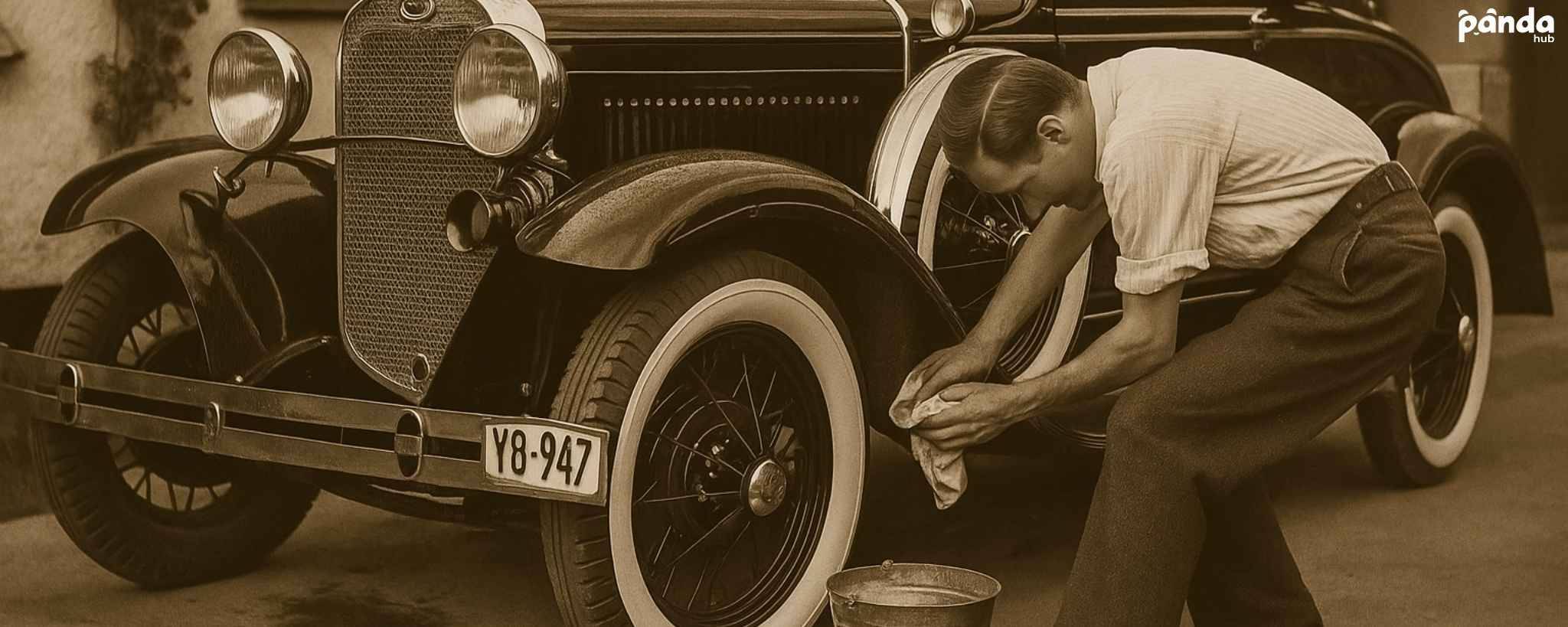The History and Evolution of Auto Detailing
Ever wonder how we got from greasy animal fat to nanotech paint protection? See what’s behind today’s billion-dollar auto detailing industry!

Written by:
Parham Koukia
Reviewed By:
Editorial Team
Published: July 14, 2025
Updated: September 22, 2025
Use AI to summarize this article:
Let's shout about it together! Auto detailing goes beyond basic car wash services!!!
Auto detailing is a process of restoring both the interior and exterior to near-original condition, to maintain and preserve its look and value. What began as a practical need to protect vehicles has developed into an industry blending craftsmanship, innovation, and care.
With the global detailing market projected to exceed $58 billion by 2030 (Grand View Research), the growth of auto detailing tells a story of shifting consumer habits, evolving materials, and rising expectations.
Early Days: Protecting Vehicles in the 1800s
In the early 1800s, before cars ruled the roads, horse-drawn carriages in Germany faced dusty trails and harsh weather. Owners applied animal fat to wooden panels to shield them from rain and dirt. This was the early form of paint protection.
The greasy coating from animal fat was effective but it often left an unpleasant smell and attracted insects, making it less than ideal for long rides.
By the late 1800s, as automobiles emerged, plant-based waxes replaced animal fat.
As automobiles started replacing horse-drawn transport in the late 1800s, detailing took a more refined turn.
Carnauba wax, made from Brazilian palm leaves, was introduced by German chemist Friedrich Menzer. It offered a cleaner and more appealing way to protect painted surfaces, leaving a subtle sheen while forming the foundation of modern detailing.
The Rise of Professional Detailing: 1900s to 1950s
The rise of mass-market cars in the early 1900 increased demand for car care.
In the 1920s, George Simons developed Simons Paste Wax, a carnauba-based product that gained popularity among the car owners. Detailers began offering hand-waxing services to help cars withstand the elements.
After World War II, car ownership just spiked!
By the 1950s new tools like masking tape and waterproof sandpaper designed for painters became standard in garages. They made it possible to correct minor imperfections in paint, marking a shift from basic cleaning to paint preservation.
Technological Advances: 1960s to 1990s
The 1960s and 1970s saw some big changes in automotive paint with metallic finishes and clear coats becoming more standard. These durable, glossy layers, applied over the base paint of vehicles required specialized care.
The introduction of polymer sealants offered a synthetic alternative to natural wax, providing longer-lasting protection for a car’s exterior. Detailers could now apply these sealants to the hood, doors, and trunk to guard against UV rays and road grime.
At the same time, new polishing machines reduced the need for manual buffing. These tools made it easier to correct paint imperfections without excessive physical effort, improving both speed and consistency.
By the 1990s, materials like microfiber towels and clay bars became standard in detailing.
Microfiber replaced cotton rags for interior and exterior surfaces and reducing scratches while improving cleaning efficiency.
Clay bars were extremely helpful to smooth out the paint as it helped in removing embedded contaminants that washing couldn’t handle.
These advancements made detailing more efficient and less physically demanding while raising the quality of results.
Modern Detailing: 2000s to Today
In the early 2000s detailing entered a new phase with the introduction of ceramic coatings. Brands like Gtechniq led the way by offering long-lasting, nanotech-based layers that bond with a vehicle’s clear coat. These coatings repel water, block UV rays, and provide shine that lasts for years, far beyond what wax or sealant could deliver.
Interior detailing has also evolved ever since.
Steam cleaning now allows detailers to sanitize upholstery and dashboards without chemicals. Waterless wash systems, relying on lubricated sprays, clean exteriors efficiently without running water, an important feature in drought-prone regions.
Also Read: How to Detail Car Interior
Mobile detailing services have now become increasingly popular. Equipped with compact tools and eco-safe products, mobile professionals can detail everything from tires to headliners in the comfort of a customer’s driveway.
Eco-Friendly Trends in Car Detailing
As environmental awareness grows, many detailers have moved toward biodegradable soaps and water-saving techniques.
Brands like Chemical Guys and Eco Touch have developed formulas that clean effectively without harming ecosystems. Waterless washing or rinseless car wash, once a niche, is now mainstream, especially in urban areas and climates where water conservation is essential.
Technological Integration in Auto Detailing
Technology continues to transform car detailing. Graphene coatings, an evolution of ceramic coatings, offer even greater durability and heat resistance, protecting a car’s paint from harsh sunlight and road debris. Smart tools, like paint thickness gauges, measure the depth of a vehicle’s clear coat, ensuring detailers avoid over-polishing areas like the hood or doors.
The integration of Internet of Things (IoT) devices is another emerging trend. Some detailing shops now use sensors to monitor humidity and temperature during paint correction, ensuring optimal conditions for applying coatings to a car’s exterior. While still in early stages, AI-powered tools, such as automated polishing machines, are being tested to enhance precision, according to a 2024 article from Carwash.com.
Why Car Detailing Matters Today
Car detailing has evolved from a luxury to a necessity for many owners. Car detailing is no longer just for car shows. Regular detailing, including cleaning the vehicle’s undercarriage and waxing its body, prevents rust and maintains resale value.
Quick Guide: Modern Detailing Practices
For those who want to try car detailing on their own, here’s a quick guide to modern techniques to detail a car:
- Wash the Wheels First: Start with the tires and rims to remove brake dust and road grime. A soft brush reaches tight spaces, ensuring no dirt scratches the paint later.
- Use a Two-Bucket Wash: Fill one bucket with car shampoo and another with plain water to rinse your mitt, preventing dirt from scratching the vehicle’s body.
- Apply a Clay Bar: Gently rub a clay bar over the car’s hood and doors to lift contaminants like sap or tar. Applying a clay bar creates a smooth surface for waxing or coating.
- Protect with Sealant or Coating: Apply a ceramic coating or synthetic sealant to the vehicle’s exterior for long-lasting protection against UV rays and dirt. Follow with tire dressing for a polished look.
- Clean Glass Last: Use a glass cleaner on the windshield and windows to remove smudges, ensuring a streak-free view for safer driving.
Here’s a full guide on the correct order to detail a car.
The Future of Car Detailing
Car detailing will continue to evolve with sustainability and technology at its core. Subscription-based detailing services and mobile car detailing services are gaining attention for offering consistent care without the hassle of one-off bookings and the need to drive to the shops.
The only thing that hasn’t changed since day one is the importance and the value of keeping your car clean. As cars become more technologically advanced, we believe the tools and techniques used to care for them will get advanced as well.

Parham Koukia
Lead Car Detailer / Operations Manager
With nearly 15 years of hands-on detailing experience, Parham has become a trusted authority in the auto care world. His work is regularly spotlighted in leading outlets like CNN, GoBankingRates, and Family Handyman. Parham likes to share his knowledge to offer in-depth tips on equipment selections, seasonal car care, and some secret car cleaning tips used by detailers in the real world!
Read more